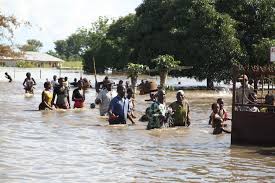BUT the real work remains undone. What was the root cause of this flooding that displaced millions in the North-East? With a plethora of governmental institutions, including the Nigeria Meteorological Agency (NiMET), why did we not have accurate intelligence or early warning systems to forestall this disaster? Nigeria’s reactive approach to disaster management is a recurring theme: each year, communities face floods, and each year, relief arrives too late for many.
It is impossible to ignore the impact of climate change on these weather patterns. This flood is not an isolated incident but part of a broader, troubling trend of extreme weather events linked to global climate change. In 2022 alone, floods across Nigeria displaced over 2.8 million people, with Borno among the worst affected states. Yet, how seriously are we taking climate change? Our policies and actions seem disconnected from the urgent need to build climate resilience. Despite being one of the world’s most climate-vulnerable countries, Nigeria’s response to these challenges is often piecemeal and needs a more strategic vision.
The Borno flood is an exposé on deeper, systemic issues plaguing our government and country. Beyond the relief efforts, it is time for the government and stakeholders at all levels to address sustainable development, particularly poverty alleviation, environmental degradation, and the dire lack of requisite infrastructure that makes our communities vulnerable to disasters. It is high time governments adopt proactive policies that anticipate potential disasters, rather than merely reacting after they occur. This includes monitoring dams and related infrastructure, regular updates to disaster response plans based on past experiences, and integrating climate adaptation strategies.
Nigeria does not have a comprehensive warning system for landslides, floods, and other natural disasters. We tend to wait until calamities strike before mobilising resources for the affected, highlighting the inefficiencies and inconsiderate disposition of our political leaders. The urgent need for a comprehensive warning system cannot be overstated. Very often, short-term political agendas overshadow long-term flood and disaster prevention measures.
As I stated in my earlier essay on reactive governance, dated 10 July, 2023, our political leaders cannot continue to prioritise short-term relief over long-term readiness and resilience planning. This short-sightedness hampers effective disaster management in situations like the Borno flood. The emphasis on short-term aid reflects a larger pattern in which political narratives precede genuine efforts to implement innovative measures to avert future disasters. Moreover, it undermines the efficiency of response efforts when disasters do occur.
The critical question is: What kind of flood management system do we need to implement to prevent a repeat occurrence? Here are some key strategies that Nigeria, should consider adopting:
First, is building comprehensive flood risk mapping and early warning systems. Flood risk mapping is essential for identifying flood-prone areas and implementing risk reduction measures. By investing in robust, real-time, early warning systems, authorities can provide timely alerts to residents, enabling them to take precautionary measures. These systems should be integrated with weather forecasts from the Nigeria Meteorological Agency (NiMET) and real-time river basins and dams monitoring.
The second is improving and maintaining dams and drainage systems. Critical infrastructure failures like the Alau Dam are a significant contributing factor to Borno’s flooding. Regular maintenance and upgrading of dams, levees, and drainage systems are vital to ensure they can withstand extreme weather events. Governments should establish a monitoring framework to regularly assess the integrity of such infrastructures and carry out necessary repairs and reinforcements.
Third, is the need for a reforestation and sustainable land management project. Deforestation and land degradation significantly increase flood risks by reducing the land’s natural ability to absorb water. Reforestation, particularly in flood-prone areas, helps stabilise soil and reduce runoff. Promoting sustainable agricultural practices and managing land use can also mitigate flood impacts.
Fourth, is executing urban planning and flood-resilient infrastructure. Urban areas in Nigeria often suffer from poor drainage, unregulated building practices, and inadequate flood defences. Enforcing stricter urban planning regulations and investing in flood-resilient infrastructure, such as elevated roads, floodwalls, and permeable pavements, can reduce the impact of flooding. Moreover, the relocation of communities from high-risk zones to safer grounds should be considered.
Fifth, is to create a community-based flood management. Engaging local communities in flood management initiatives ensures that responses are tailored to the specific needs and vulnerabilities of the population. This includes raising awareness about flood risks, emergency preparedness training, and involving communities in maintaining flood defences. Community-led initiatives can enhance resilience and ensure faster, more coordinated responses when floods occur.
The sixth is to develop and implement a climate change adaptation strategy. As extreme weather events become more frequent due to climate change, Nigeria must develop a comprehensive climate adaptation plan. This includes integrating climate risk assessments into national and regional planning, adopting water conservation techniques, and creating policies that promote climate-resilient agriculture. Proactive climate action can significantly reduce the long-term impact of flooding.
Finally, providing Integrated Water Resources Management (IWRM). Effective flood management requires a holistic approach that considers upstream and downstream impacts. IWRM promotes coordinated development and management of water, land, and related resources, ensuring that flood prevention measures are harmonised across sectors and regions.
Natural disaster prevention and management are intrinsically linked to how seriously we take climate change. All stakeholders must take urgent and sustained action to address the issue at stake because the severe threats posed by climate change demand it. This is especially true in Nigeria, where a sizable part of the population depends on agriculture and other climate-sensitive sectors for their livelihood. Therefore, the government must implement practical, tangible, and fit-for-purpose measures to mitigate climate change risks and ensure sustainable development.
This is a clarion call for change. The Borno flood must not just be another tragic entry in our history books but a pivotal moment that sparks transformative action. The path forward demands courage, commitment, and the will to prioritise our collective future over the moment’s politics.


